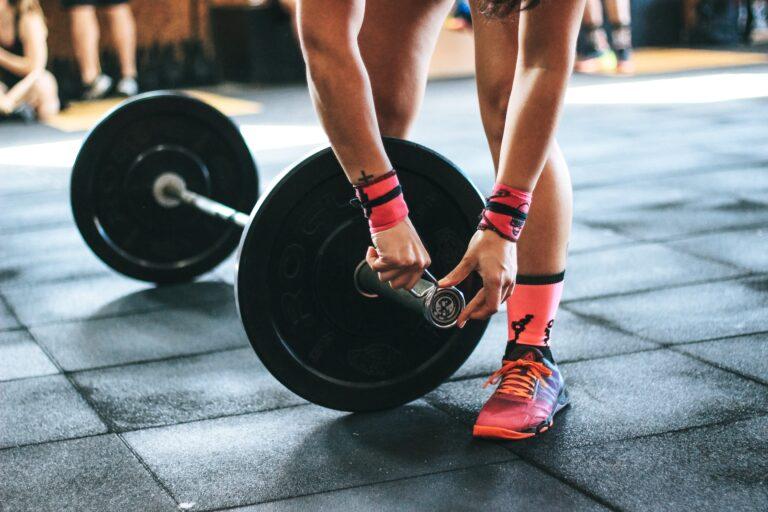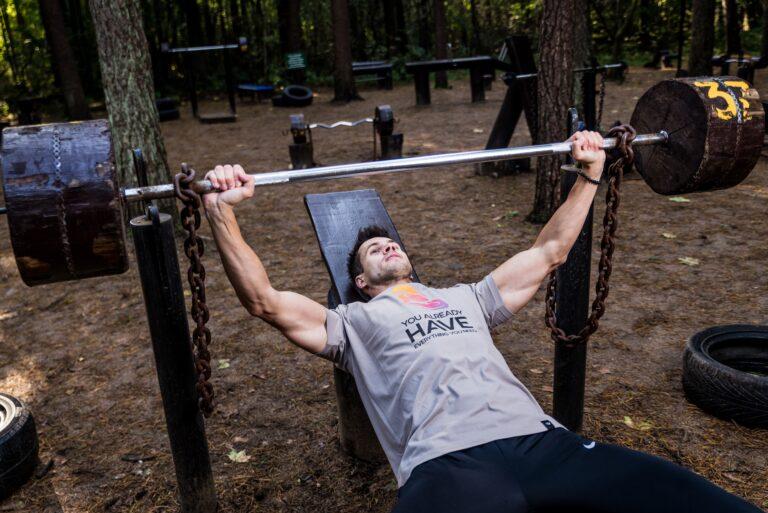Are you ready to unlock your full potential and unleash the power within? Get prepared because weight lifting for beginners is the ultimate path to building strength and boosting your confidence!
Did you know that only 20% of adults meet the recommended guidelines for strength training? That means most are missing out on the incredible benefits of lifting weights. But fear not because this article is here to guide you step by step to becoming a stronger, more powerful version of yourself.
We’ve covered everything from bodyweight exercises to dumbbell workouts, kettlebell training, and barbell lifting. You’ll learn to recruit every muscle fiber and achieve progressive overload, the key to building strength.
Everyone has the potential for greatness; with the proper support and knowledge, you can reach heights you never thought possible.
So get ready to embark on this exciting adventure of self-discovery and empowerment. It’s time to tap into that subconscious desire for power and become the best version of yourself. Whether you’re a beginner or have dabbled in weight lifting, this article will equip you with everything you need to know.
Get ready to lift those weights confidently, and watch as your strength soars!
Starting strength training
Starting strength training is crucial for beginners to build confidence and develop their physical strength, as discussed in Women’s Health. For beginners, this guide offers a comprehensive training plan for building strength. It covers the benefits, terminology, tips, and exercises needed to succeed. As your strength improves, you can move on to isolating specific muscles and pushing them to their maximum potential.
When starting your strength training routine, it’s essential to focus on different muscle groups. A well-rounded program should include exercises that target major muscle groups such as legs, chest, back, shoulders, and arms. By working these muscle groups in a balanced manner, you’ll enhance your overall strength and improve your physique.

Proper form and technique
When it comes to weightlifting for beginners, proper form is essential. It ensures that you’re using the correct muscles during each exercise and reduces the risk of injury. Mastering good conditions is crucial for building a solid foundation and setting yourself up for future progress.
The guide emphasizes the importance of maintaining good posture, engaging your core, and performing each movement with control. By focusing on proper form and technique, you’ll maximize the effectiveness of your workouts and minimize the chance of injury.
The role of progressive overload
Now that you understand the importance of proper form and technique let’s dive into the concept of progressive overload. One of the main benefits of following a structured beginner’s guide is that it provides clear instructions on performing each exercise correctly.
This eliminates any confusion or guesswork and allows you to focus on getting stronger without worrying about whether you’re doing it right or not. Progressive overload is the key to building strength effectively. It involves gradually increasing the intensity or challenge of your workouts over time. You’ll progress steadily on your power training journey by consistently pushing your muscles to adapt and grow stronger.
Bodyweight exercises
With bodyweight exercises, you’ll be amazed at the incredible progress you can make on your journey to becoming a formidable force. Bodyweight exercises are an excellent choice for beginners in strength training as they allow you to use your body as resistance. These exercises target multiple muscle groups simultaneously and provide a solid foundation for building strength.
Whether it’s push-ups, squats, or lunges, bodyweight exercises engage your upper and lower body, helping you develop functional strength that translates into real-life movements.
To incorporate bodyweight exercises into your strength training program, choose various activities targeting different muscle groups. For your upper body, push-ups and tricep dips are great options to strengthen your chest, shoulders, and arms.
To work on your lower body, squats and lunges effectively target your glutes, hamstrings, and quadriceps. Aim to perform each exercise with proper form and gradually increase the number of repetitions or sets as you get stronger.
Another advantage of bodyweight exercises is their scalability. You can easily adjust the difficulty level by modifying the range of motion or adding variations like single-leg squats or decline push-ups. This allows you to continually challenge yourself and progress at a pace that suits your fitness level.
As you become more comfortable with bodyweight exercises, don’t hesitate to experiment with advanced variations such as handstand push-ups or pistol squats.
Incorporating bodyweight exercises into your strength training routine helps build muscle and improves overall stability and coordination. These exercises promote efficient motor unit recruitment and enhance neuromuscular control by engaging multiple muscle groups simultaneously.
So remember, embrace the power of bodyweight exercises on your path to building strength and confidence!
Dumbbell exercises
Enable your workout routine with various versatile and practical dumbbell exercises. Dumbbell exercises are a fantastic way to incorporate weight lifting into your strength training routine, especially for beginners like yourself. By adding dumbbells to your workouts, you’ll not only build strength but also increase your confidence in the gym.
These exercises target multiple muscle groups and provide a challenging yet manageable resistance to help you progress toward your fitness goals.
One of the great things about dumbbell exercises is their versatility. You can perform various movements with just a pair of dumbbells, targeting different muscle groups. From bicep curls and shoulder presses to squats and lunges, there’s no shortage of exercises you can do with dumbbells. This variety keeps your workouts exciting and prevents boredom from setting in, ensuring that you stay motivated on your path to strength and confidence.
Incorporating dumbbell exercises into your weightlifting routine allows for progressive overload. As you start with lighter weights and gradually increase the load, you’ll challenge your muscles to adapt and grow stronger.
This progressive overload is critical for building strength effectively as a beginner. With consistent effort and proper form, you’ll be amazed at how quickly you see improvements in your physical abilities and overall confidence.
Not only are dumbbells easily accessible in most gyms, but they also offer other advantages for beginners like yourself. Unlike barbell training, which requires specific equipment setups, using dumbbells provides more flexibility in terms of space-saving options.
Additionally, working with two different weights forces each side of your body to stabilize independently during movements, leading to better balance development overall. So grab those dumbbells confidently, knowing they are an excellent tool for building strength while enhancing your body’s stability.
So why wait? Start incorporating some exciting new dumbbell exercises into your weightlifting routine today! Push yourself to try different activities and challenge your body in new ways. Remember, consistency is vital, so gradually increase the weight as you get stronger.
As you progress on your fitness journey, you’ll build strength and gain the confidence that comes with knowing you’re taking control of your health and well-being. Keep lifting those dumbbells and reap the rewards of increased strength, improved physique, and unwavering confidence!
Kettlebell workouts
Incorporating kettlebell workouts into your routine can provide a dynamic and challenging alternative to traditional strength training exercises. For example, imagine you’re a beginner who wants to improve your fitness and coordination.
Incorporating kettlebell swings into your workout routine allows you to engage multiple muscle groups while increasing your cardiovascular endurance. Kettlebell swings require explosive hip power, which helps build strength and improves muscular endurance.
To perform a kettlebell swing, start by standing with your feet shoulder-width apart and the kettlebell on the ground in front of you. Hinge at the hips and grab the kettlebell handle with both hands, keeping your back straight and core engaged.
From this position, explosively drive your hips forward as you swing the kettlebell up to chest level, using the momentum generated from your lower body. As you turn the kettlebell back between your legs, maintain control and keep tension in your glutes and hamstrings.
In addition to improving overall fitness, incorporating kettlebell workouts into your routine can help build muscle. Kettlebells allow for a wide range of exercises that target different muscle groups, such as squats, lunges, overhead presses, and rows. These compound movements work multiple muscles simultaneously and promote functional strength that translates into real-world activities.
If you’re new to kettlebells or unsure about proper form or technique, seeking guidance from a certified personal trainer or watching instructional videos online is always beneficial. This will ensure that you perform the exercises correctly and minimize the risk of injury during weight training sessions. Remember to start with lighter weights until you feel comfortable with the movements before gradually increasing the load.
So why not add some excitement to your strength training routine? Incorporating kettlebell workouts can challenge your body and mind while helping you achieve greater strength and confidence. Whether through volatile swings or other dynamic exercises, these versatile tools offer a unique way to build muscle, improve coordination, and enhance overall fitness.
Barbell lifting
The barbell clean and jerk is one explosive movement that can transform your workout routine. This dynamic exercise combines strength, power, and coordination to target multiple muscle groups simultaneously. You engage your entire body by lifting weights with the barbell clean and jerk, including your legs, core, back, shoulders, and arms.
It’s a compound exercise that builds strength and improves explosiveness and athleticism.
When performing the barbell clean and jerk, start by gripping the barbell with an overhand grip slightly wider than shoulder-width apart. Bend at your hips and knees while keeping a neutral spine position. Explosively extend your hips and knees while shrugging your shoulders upward to lift the barbell off the ground.
As it reaches chest height, quickly drop under it by squatting down while flipping your elbows forward to catch it in a front rack position on the front of your shoulders. From there, use a push press or push jerk motion to drive the weight overhead until you reach the full extension of your arms.
This challenging exercise targets fast-twitch muscle fibers for explosive power and slow-twitch muscle fibers for endurance. Incorporating barbell lifting into your strength training routine builds overall strength, improves muscular endurance, and enhances coordination between different muscle groups. This exercise’s intensity allows for maximum muscle fibers recruitment throughout your body.
Suppose you’re new to barbell lifting or unsure about proper form and technique. In that case, it’s essential to seek guidance from a qualified trainer or coach who can provide instruction on performing the movement safely and effectively. They can help you maintain the correct posture throughout each lift phase to prevent injury.
Incorporating barbell lifting into your strength training routine will take your workouts to another level by challenging multiple muscle groups simultaneously. The barbell clean and jerk is an effective compound exercise that engages various muscles, improving coordination and explosiveness.
Don’t be afraid to push yourself and embrace the power of lifting weights. Remember to prioritize proper form and technique and seek guidance from a professional if needed.
Get ready to unleash your inner strength and take your fitness journey to new heights with barbell lifting.
Motor unit recruitment
Improve your overall muscle activation and coordination by focusing on motor unit recruitment, which involves effectively engaging the nerve cells that control your muscle fibers. This is a crucial aspect of resistance training and will significantly benefit your strength training journey.
When you focus on motor unit recruitment, you’re essentially teaching your body to work efficiently and effectively, maximizing the benefits of strength training.
One of the key benefits of strength training is that it allows you to lift heavier weights over time. By consistently challenging yourself with increasing resistance, you stimulate your muscles to adapt and grow stronger. However, lifting heavier weights requires proper motor unit recruitment.
Engaging more muscle fibers through effective motor unit recruitment increases your overall strength and power.
It’s important to note that motor unit recruitment can be a learning curve for beginners. Developing the mind-muscle connection needed for optimal muscle activation requires practice and patience. But don’t let this discourage you!
Focusing on motor unit recruitment during workouts will gradually improve your coordination and ability to recruit more muscle fibers.
As your strength training journey progresses, incorporating exercises challenging different movement patterns will further enhance your motor unit recruitment. For example, compound movements like squats and deadlifts require coordination between multiple muscle groups, leading to greater muscle activation. So don’t shy away from these exercises – embrace them as opportunities to improve your motor unit recruitment skills.
Improving motor unit recruitment is essential to any effective strength training program. You can optimize coordination and overall muscle activation by engaging the nerve cells that control your muscle fibers.
Remember that there may be a learning curve when developing this skill, but it’ll become second nature with persistence and dedication.
Embrace the challenge of lifting heavier weights and incorporate exercises that challenge different movement patterns for maximum results in your strength training journey.
Progressive overload
To make consistent progress on your strength training journey, it’s crucial to continually challenge yourself by gradually increasing the resistance you use in your workouts. This concept, progressive overload, is the key to building strength and muscle.
By progressively overloading your muscles, you force them to adapt and become stronger over time. Here are some ways you can incorporate progressive overload into your weightlifting routine:
-
Increase the weight
One of the simplest ways to apply progressive overload is to increase the weight you lift. As you get stronger, gradually add more weight to your exercises. Start with a weight that allows you to perform proper form for 8-12 repetitions, and once that becomes easy, move up to a heavier weight.
-
Increase the repetitions
Another way to overload progressively is by increasing your repetitions for each exercise. If you started with ten reps for an activity, aim to do 12 or 15 reps in subsequent workouts. This higher volume will challenge your muscles differently and promote further strength gains.
-
Decrease rest periods
Shortening your rest periods between sets can also effectively apply progressive overload. By reducing the time between groups, you increase the intensity of your workout and push your muscles harder.
-
Change exercises or variations
Don’t be afraid to switch up your exercises or their variations occasionally. Trying new movements engages different muscle groups and prevents plateaus in strength gains.
By incorporating these strategies into your workout plan, you can ensure that you’re consistently challenging yourself and making progress toward becoming more robust and more confident in your weightlifting journey. Working with a personal trainer who can guide you through proper form checks and help tailor a program specifically for your goals and abilities is always beneficial.
1-on-1 Coaching
If you’re ready to take your strength training journey to the next level and want personalized guidance, consider enrolling in a 1-on-1 Coaching Program for a tailored program designed specifically for you. This program will provide you with the support and expertise of a coach who will guide you every step of the way.
They will work with you to create a customized workout plan that considers your goals, fitness level, and any limitations or preferences you may have. Whether you want to improve your push-ups, master bicep curls, or strengthen your lower body, the 1-on-1 Coaching Program is here to help.
One of the advantages of enrolling in the 1-on-1 Coaching Program is access to a well-equipped weight room. With equipment like squat racks and barbells, you can challenge yourself and progress significantly in your strength training journey.
Your coach will teach you proper form and technique for squats, deadlifts, bench presses, and more. They will also provide feedback and ensure you perform each exercise safely and effectively.
In addition to providing personalized workouts in the weight room, the 1-on-1 Coaching Program also offers nutrition and recovery strategies guidance.
Your coach will help you develop a balanced diet that supports your strength training goals while ensuring proper fueling for optimal performance. They will also educate you on the importance of rest, recovery days, and techniques for managing soreness and preventing injuries.
By enrolling in the 1-on-1 Coaching Program, you will receive personalized guidance from an experienced coach and gain confidence in your abilities as you progress weekly. You’ll be motivated by achieving new personal records or mastering challenging exercises under their expert supervision.
Frequently Asked Questions
How do you start strength training for beginners?
Start by incorporating bodyweight exercises into your routine, focusing on proper form and gradually increasing the intensity. As you progress, you can incorporate dumbbell or kettlebell exercises and eventually move on to barbell lifting. Consistency and gradual progression are key!
Does weightlifting build confidence?
Absolutely! Weightlifting helps build physical strength, which translates into increased self-confidence. You’ll feel empowered and more confident in your abilities as you see improvements in your power and physique. It’s an incredible journey of self-discovery and empowerment!
How can nutrition support strength training?
Proper nutrition is key to supporting strength training. A balanced diet of protein, complex carbohydrates, and healthy fats will provide the necessary energy for your workouts and help with muscle recovery and growth. It’s also important to stay hydrated, and depending on the intensity of your training, you might need to consider supplementing your diet with essential vitamins and minerals.
What are some effective dumbbell exercises for beginners?
Some effective dumbbell exercises for beginners include squats, lunges, shoulder presses, bent-over rows, and bicep curls. These exercises target multiple muscle groups and can help you build strength and confidence in your fitness journey.
Is it necessary to lift heavy weights to build strength?
No, lifting heavy weights is not the only way to build strength. Beginners can start with bodyweight exercises and gradually progress to using weights. By focusing on proper form, gradually increasing intensity, and incorporating progressive overload, you can build strength effectively without always lifting heavy weights.
Conclusion
Embark on your journey to strength and confidence. Incorporate bodyweight exercises, dumbbell workouts, kettlebell training, and barbell lifting into your routine. Remember to focus on proper form and technique, embrace progressive overload, and prioritize motor unit recruitment. Seek personalized guidance through our 1-on-1 Coaching Program. You’ll achieve your fitness goals and unlock your full potential with dedication and consistency. Lift those weights, unleash your inner power, and soar to new heights of strength and confidence!
References
https://www.womenshealthmag.com/uk/fitness/strength-training/a706202/strength-training-for-beginners/
https://www.menshealth.com/uk/building-muscle/a756325/10-best-bodyweight-exercises-for-men/
https://www.medicalnewstoday.com/articles/progressive-overload
https://www.webmd.com/fitness-exercise/ss/slideshow-bodyweight-exercises


















